

Jon Clements, Author (unless otherwise noted) and Editor
Current degree day accumulations
New England Tree Fruit Management Guide on-line
| UMass Cold Spring Orchard, Belchertown, MA |
15-May |
| Base 43 (BE, NEWA) | 566 |
| Base 50 (BE, NEWA) | 280 |
Current bud stages. May 15, 2017, UMass Cold Spring Orchard, Belchertown, MA
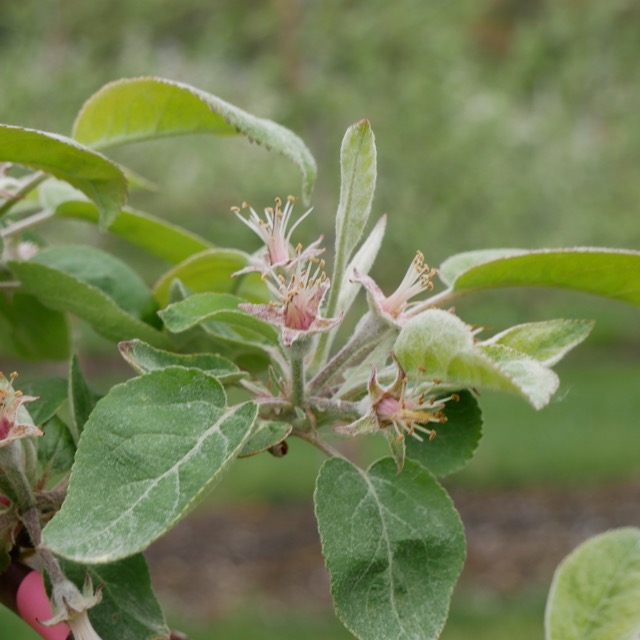 |
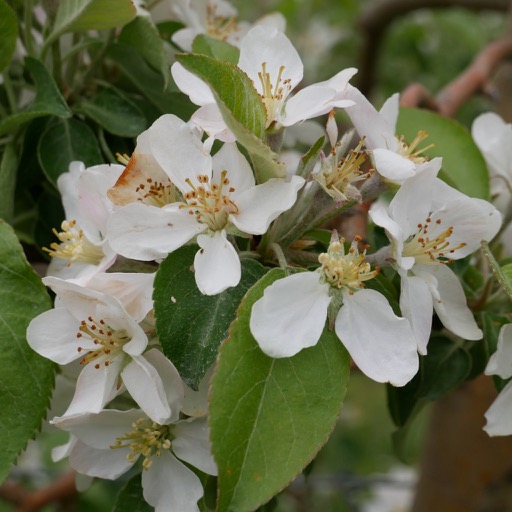 |
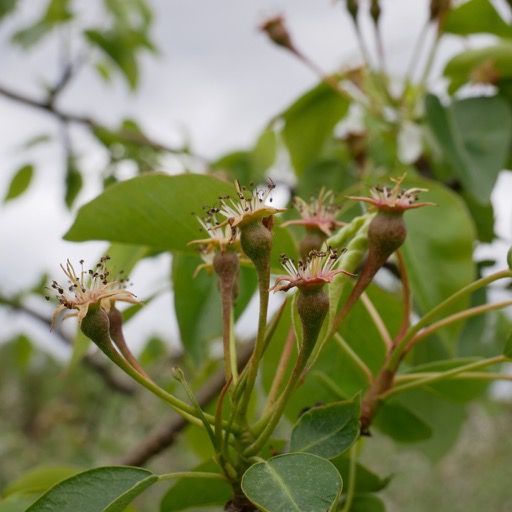 |
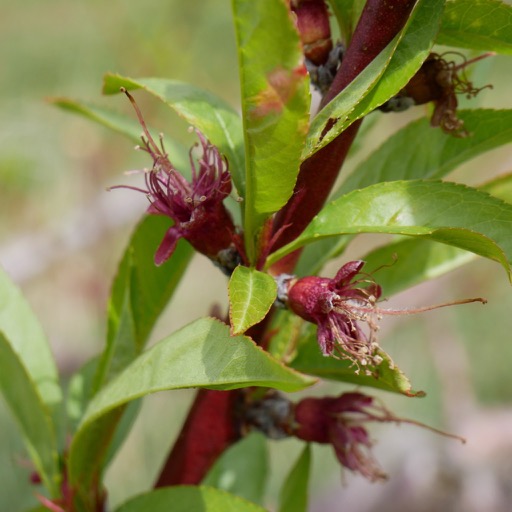 |
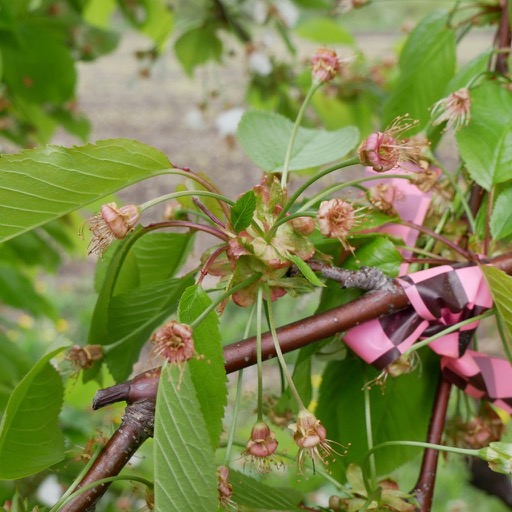 |
McIntosh apple petal fall |
Honeycrisp apple late bloom |
Gold bosc pear fruit set |
Redhaven peach fruit set |
Regina sweet cherry petal fall/fruit set |
Note: this will be the last Current bud stages update for 2017; for archive of bud stages, see Bud Stages Photos
| Coming events | Degree days (Base 43 BE) |
| Codling moth 1st catch | 396-566 |
| Codling moth 1st flight peak | 558-971 |
| Lesser appleworm 1st flight peak | 364-775 |
| Pear psylla adulst & hardshells present | 408-606 |
| San Jose scale 1st catch | 438-614 |
| San Jose scale 1st flight peak | 557-734 |
| Spotted tentiform LM sapfeeding mines present | 343-601 |
| White apple leafhopper nymphs on apple | 302-560 |
| McIntosh fruit set | 506-596 |
Key insect life cycle and management dates
Note: for 2017, we have four Massachusetts orchard locations subscribed to AR: Amherst, Belchertown, Deerfield, and Easthampton. The website for looking at AgRadar for these locations is: http://extension.umaine.edu/ipm/ag-radar-apple-sites/. What follows is the AgRadar summary for the Belchertown location.
Estimated apple Scab Ascopsore Maturity, 15-May -- 94%; predicted to be at 99% on Thursday, May 18.
Codling moth CM -- 1st generation, first sustained trap catch biofix date: May 16, Tuesday. Codling moth development as of May 16: 1st generation adult emergence at 1% and 1st generation egg hatch at 0%. In most orchards, insecticide targetted against plum curculio and apple maggot prevent codling moth damage. If targetted codling moth control is needed, key management dates are: 1st generation 3% CM egg hatch: June 5, Monday, = target date for first spray where multiple sprays needed to control 1st generation CM.
Lesser Appleworm LAW -- 1st LAW flight begins around: May 6, Saturday. Peak trap catch: May 19.
Oriental Fruit Moth OFM -- 1st generation OFM flight starts: April 26, Wednesday. 1st generation 55% egg hatch and first treatment date, if needed: May 25, Thursday.
Plum curculio (PC) -- Increased risk of PC damage as McIntosh and similar cultivars increase in fruit size: May 18, Thursday.
San Jose Scale (SJS) -- First adult SJS caught on trap: May 17, Wednesday.
Spotted Tentiform Leafminer STLM -- 1st STLM flight, peak trap catch: May 4, Thursday. 1st generation sapfeeding mines start showing: May 19, Friday. Optimum sample date is around Saturday, May 20, when a larger portion of the mines are visible.
McIntosh Bud Stages -- Wednesday, May 3: Full Bloom; Friday, May 12: 95% Petal Fall; Tuesday, May 16: 100% Petal Fall (which appears to be spont on BTW).
11-July, 2017 (Tuesday) Massachusetts Fruit Growers' Association Summer Meeting, Cider Hill Farm, Amesbury, MA. Details TBA.
For more information and updates, see Upcoming Events
Jon Clements
• Insect and disease issues are briefly covered by Liz Garofalo. I will only say plum curculio and fire blight would be on my radar screen this week. Remember, fire blight infection requires open bloom (maybe in some locations and some varieties), heat (definitely looks like it), and some wetting (rain or heavy dew); wetting looks iffy this week, not sure what is going to happen there this week, but be prepared with some streptomycin if you have any bloom open, and we get some wetting.
• Oh yea, and apple fruitlet thinning. See Duane Greene's comments, and here are a few of my favorite talking points:
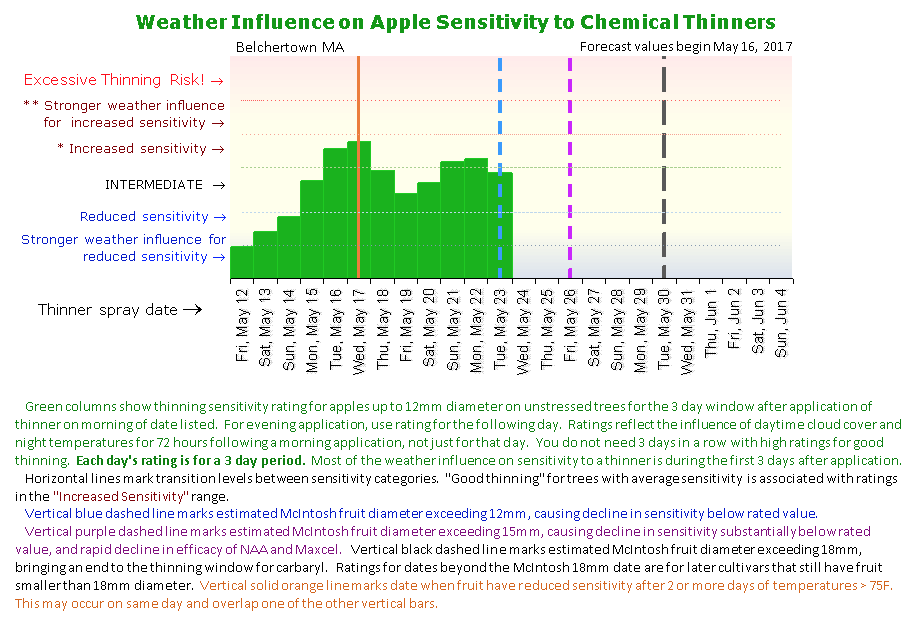
• The New England Extension tree fruit specialists -- which include myself and Dan Cooley at UMass. Mary Concklin at UConn, Heather Faurbert at URI, Terry Bradshaw at UVM, George Hamilton and Alan Eaton at UNH, and Glen Koehler and Renae Moran at UMaine -- have started to contribute to an on-line edition of the New England Tree Fruit Management Guide. Call it a beta version if you will, but we think it has some value in 2017 as we continue to work on it. (Consider it dynamic? Work-in-progress? Under construction?) But many of the spray tables (for lack of a better description) are filled out. Note that is it easy to print any of the sections, if you want to have old-school reference, for examplle, to hang on your spray shed wall. Also, it is quite mobile-friendly so make a home screen shortcut to here: http://netreefruit.org.
Elizabeth Garofalo
Oriental fruit moth (OFM) has been popping up all over the map (no, really, see the map below). The red dots represent locations where we have caught and positively ID’d OFM so far this season. We should just about be at the peak of first flight (508 DD base 43 accumulation beginning Jan. 1, as of 5-15-17, according to NEWA).
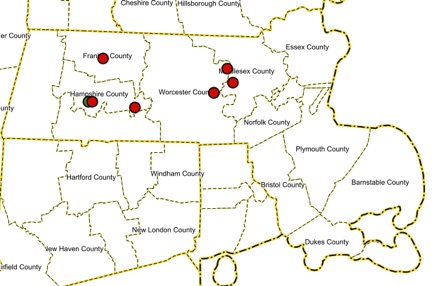 |
So what, we all know its there, right? Well, first of all, you’ll want to start thinking about mating disruption for the second flight, they are the ones whose offspring will be going after the peaches (and apples in some cases) and we can’t have that! Aside from mating disruption, when you make your petal fall spray for plum curculio, consider a material that will be effective against OFM, if you have had damage from it in the past. Assail and Avaunt are both good choices with relatively low-moderate toxicity to honeybees and beneficial mites. Both will provide some control of tarnished plant bug (TPB) as well. |
| That reminds me, because TPB otherwise spends a lot of time in broadleaf weeds in the orchard grourdcover, far be it from me to pass up an opportunity to harp on the importance of weed control (you know I won’t). In a perfect world, in-row weed free strips are maintained at 3-4’ wide and between rows are kept well mowed. This is especially important in newer and high-density plantings. Dogwood borer adults will begin emerging in early June. Weeds, especially around tree trunks, will provide a great place for them to hang out until they are ready to lay their eggs in the bur knots that can develop under more humid conditions. | 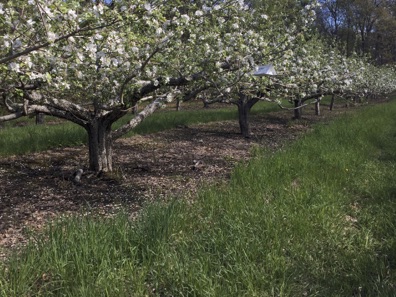 |
Even though we have a slew of pests headed our way, there are some silver linings too. First: we are officially completely free and clear of the drought (keep up those rain dances)!
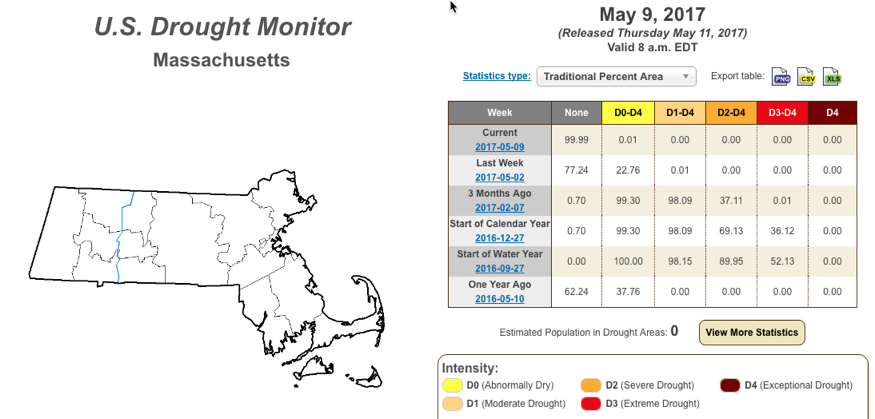
Second: Beneficial insects are on the move now. I have already seen hoverfly larva feeding on aphids and, lady beetles are out and about too.
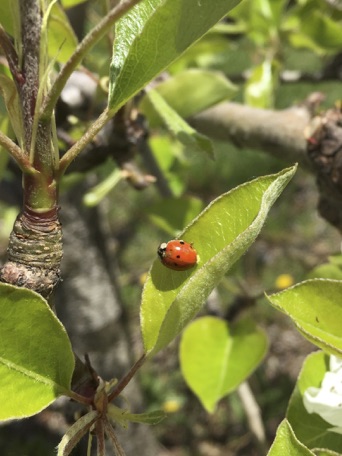
Elizabeth Garofalo
This week’s honeybee avoidance charts for Belchertown and Deerfield:
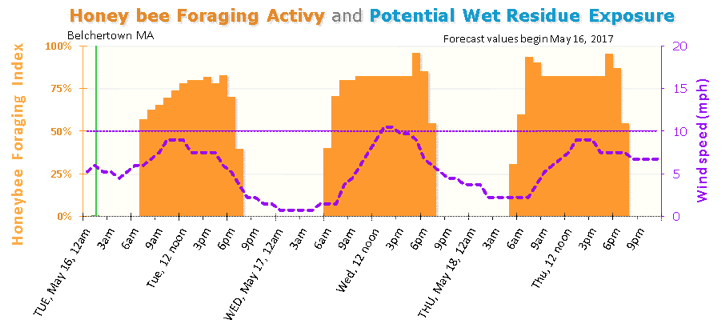
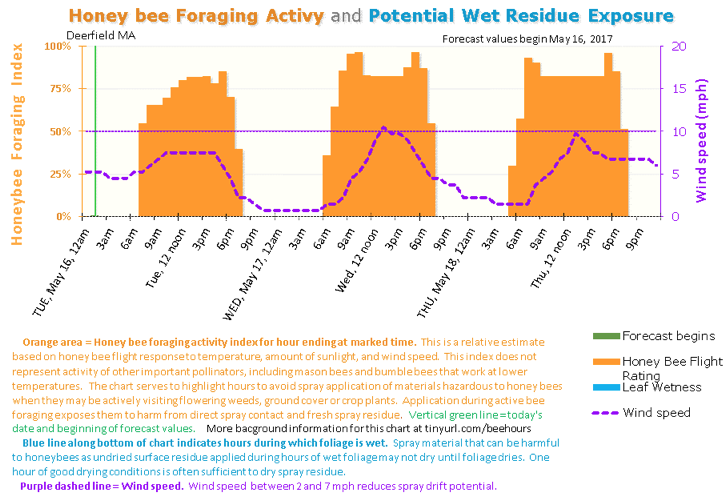
The level of activity is a significant uptick from last week’s, coinciding, of course, with increasing temperatures and decreasing (hopefully not a trend!) rainfall for the week. Great news for those of you who have been worried about pollination with all the cold, wet weather we have been seeing. We have been seeing plenty of bloom still open across the state. Speaking of open blossoms (and more good news), streptomycin, which some of you will be applying in the coming week, is rated as having a “very low” risk ranking to honey bees by the EPA. Interestingly enough, Oxidate, an organic fireblight management material, has been ranked by the EPA as a “high” toxicity risk. Which brings us to the million dollar question of the week: What about fireblight?! This week’s temperatures will provide ideal conditions for the bacteria to build population levels up to that required to cause infection, provided appropriate wetting conditions are also present, i.e., a heavy dew or rain event. If the forecast doesn’t change overmuch (I wouldn’t hold my breath on that count if I were you), we are looking at potential for infection beginning Friday, with rain predicted for Sunday.
But wait, there’s more! With rain coming in, we will have more apple scab infection events headed our way too. If I had to hazard a guess, I would say we have at least two more significant scab events to go before we can safely call it done for the season. We have found our first lesions on unsprayed trees dating back to the first event of the season, dating back to April 25, as best as we can figure for now. Once symptoms begin to show on trap trees, we will be able to say for certain.
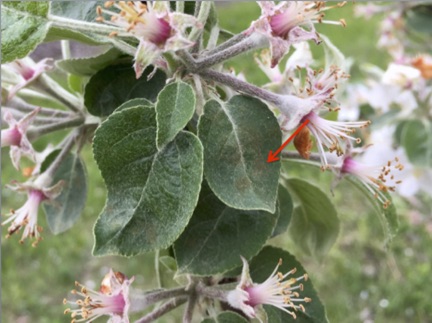
Chemical Thinning Thoughts and Suggestions (Duane Greene)
For nearly 2 weeks the weather in the northeast US has been cool windy and at times wet. This unseasonably cool weather has slowed flower and fruit development. These conditions are not conducive for good chemical thinning results. Many have applied either bloom or petal fall thinning treatments. The forecast for the next 3 to 4 days is favorable for obtaining good chemical thinning results. Generally fruit that develop and set under cool conditions are difficult to thin. Heat at this time of fruit development does not promote fruit abscission as much as during the 7-14 mm stage where there is a much larger carbohydrate demand imposed by the fruit.
The upcoming warm period is a very good opportunity to thin. I urge all to take advantage of this somewhat favorable weather and apply your thinners. However, an overarching concern I have is with the quality of pollination. Often it was cold, windy and rainy. Pollination differs from orchard to orchard so only you can assess the effectiveness of bees during this time. Closing of calyx of flowers and the development of ovules in the ovary are good indications of the amount of pollination your trees received. If concerned exercise more caution. If you are at petal fall or very close to it, carbaryl or Amid-Thin are good conservative choices to use.
Many of you have applied thinners earlier but the weather conditions following these applications did not allow for visible expression of thinning potential. Some of you may have applied a thinner within the last several days and not enough time has passed to allow the effects of thinners to express themselves. It would be unwise to miss this upcoming thinning window of opportunity with the hope that the thinners applied earlier will reduce the crop to an appropriate level. Rather, I believe that these thinners will set your trees up to be thinned more effectively with thinners applied during this time.
Some have expressed concern that the cloudy weather we have experienced for the past week or two will make fruit more vulnerable to thinners. Research as shown that apple trees can recover from a weather (cloudy) induced carbohydrate deficit quite rapidly. Cloudy weather prior to a thinner application has little influence activity of the thinner. However, if cloudy, warm weather occurs immediately following thinner application, excessive thinning may occur. While is true that leaves that develop under cool, cloudy conditions may absorb more thinner, the only situations where I have observed as significant effect is with caustic blossom thinners such as ATS. When hormone-type thinners are applied under these conditions the effect on thinning appears to be minimal.
For growers who experienced good bloom and good bee activity in their orchard this may be the best opportunity you may have to achieve good thinning. During the few days between petal fall and when fruit reach the 5-6 mm stage, fruit are not as vulnerable to thinners as when they are in the 7-14 mm stage. Over-thinning is quite unlikely. A combination of NAA or Amid-Thin with carbaryl may be the good choice for thinning.
During this past week Alan Lakso, Cornell University, originator of the Carbon Balance Model, issued a warning relative to the use and accuracy of the thinning model this year. The data used to construct the Carbon Balance Model was collected in years when somewhat “normal” weather conditions prevailed. The two main inputs into the model are temperature and solar radiation. The model starts when the trees reach the green-tip stage and it continues uninterrupted throughout the season. The model does not provide provision for modification in years such as last year (very warm) or this year (very cold). Consequently, the output from the model can be somewhat unreliable.
Available Chemical Thinners to Use this Week
Fire Blight Infection Events Expected this Week in the Champlain Valley! Anna Wallis
(Hot off the press, just re-printed from Cornell ENYCHP Tree Fruit E-Alert for May 16th 2017 @ 10:00 am)
Ed. note: this applies to orchards in Massachusetts still in bloom. I know you are out there. Also, the Cornell ENYCHP is a paid subscription, I normally don't like to "borrow" from their publications, but this is timely and important. (Hope you don't mind Dan and Anna.) If you would like to receive more of this information, I would suggest you enroll in the Cornell ENYCHP. Contact Dan Donahue (djd13@cornell.edu) or Anna Wallis (aew232@cornell.edu) for more information.
If you had fire blight in your neighborhood last year, you should be prepared to make antibiotic applications this week. Reminders below:
In light of all this, one approach is to use Regulaid or other penetrant in the initial strep application. Subsequent applications should be made without it to avoid intolerable amount of leaf yellowing.
However, under this approach there is the potential to make unnecessary applications or miss a necessary one. This strategy was originally designed for older orchards; in younger plantings (6 or 8 years old) there is often more bloom on 1-yr wood and/or true rat-tail bloom that might not be covered by strep applied at 90% bloom. In addition, it is probable that only one or two sprays will be necessary; spraying 3 times will be expensive in terms of labor and material. The ease with which the NEWA system can be used make using the forecasting models a desirable approach.
Follow me (jmcextman) on FB: https://www.facebook.com/jmcextman
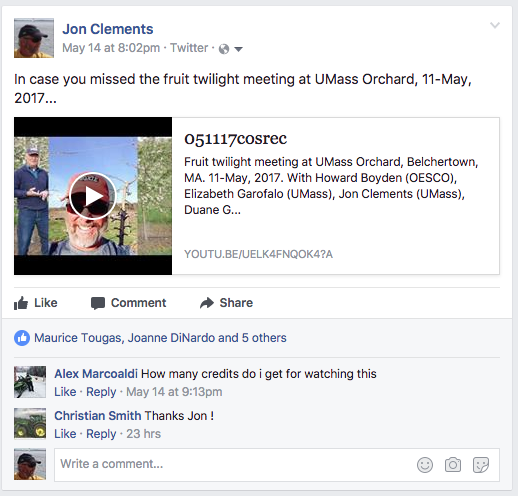
New England Tree Fruit Management Guide
UMass Fruit Advisor: http://umassfruit.com
Scaffolds Fruit Journal: http://www.nysaes.cornell.edu/ent/scafolds/
Network for Environment and Weather Applications (NEWA): http://newa.cornell.edu
Follow me on Twitter (http://twitter.com/jmcextman) and Facebook (http://www.facebook.com/jmcextman)
The next Healthy Fruit will be published on Tuesday, May 23 or thereabouts, 2017. As always feel free to get in touch with any member of the UMass Fruit Team (http://extension.umass.edu/fruitadvisor/team-members) if you have questions or comments.